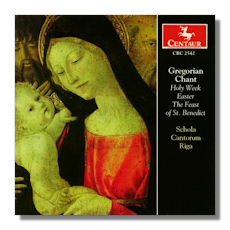
The Internet's Premier Classical Music Source
Related Links
- Latest Reviews
- More Reviews
-
By Composer
-
Collections
DVD & Blu-ray
Books
Concert Reviews
Articles/Interviews
Software
Audio
Search Amazon
Recommended Links
Site News
 CD Review
CD Review
Gregorian Chant

For Holy Week, Easter
and the Feast of St. Benedict
- Mass for Easter Sunday
- Improperium
- Ecce lignum Crucis/Popule meus
- Crucem tuam adoramus
- Crux fidelis
- Christus factus est pro nobis
- Os justi
- Domine, praevenisti eum in benedictionibus dulcedinis
- Alleluia justus ut palma
- Laeta dies
- Desiderium
- Fidelis Servus
Schola Cantorum Riga
Centaur CRC2542
This is a beautifully-sung hour and ten minutes' worth of Gregorian Chant. If you're new to this type of music and sample but a few recordings, you'll quickly realize that there are nearly as many performance styles as there are performers. It almost goes without saying that debate is lively amongst musicologists about articulation, voicing and of course the pronunciation of the "dead" Latin language. This in some ways accounts for such variance. Just as relevant is the fact that Gregorian chant has gained something of a cult status in recent years; though much of what has been recorded is far from authentic. A travesty indeed. So there is varnish, whitewash, celluloid to be stripped away. Whatever angle you come to Gregorian chant from, in the end you may simply want to enjoy and respond to the beauty of plain, uncluttered singing. In that case, you'll welcome that this is a performance without "effects", without instruments, bells or (polyphonic) additions. And the music benefits immeasurably from such an approach. On this recording by the Schola Cantorum Riga you're listening to the chant, not the sound or the interpretation.
It's generally accepted that "Gregorian" chant (so called from respect for Pope Gregory I (d. 604 CE), not because Gregory had much of a hand in the music itself) originated from early Jewish chant and evolved as a way to enhance Biblical and devotional texts in acts of worship. So it's all to the good that the Schola Cantorum Riga has such a pleasingly "pure", unstylized, and clear delivery on this delightful CD.
The Schola Cantorum Riga was formed in 1995 specifically to perform authentic Gregorian chant. Based in Latvia, its dozen or so singers aim for a particularly high standard of research and delivery consistent with their roles as professional singers now in increasingly greater demand both in the Baltic countries and further afield. From the first minute it's impossible not to appreciate this – and how far the ensemble has succeeded in meeting their own goals. The founder and artistic leader of the Schola Cantorum Riga is Guntars Pranis (b. 1971). He also teaches at the Latvian Music Academy, where his expertise extends to hymnology, liturgy and choral singing more generally. Four soloists are identified on this recording, two high voices and two low, on 15 of the 19 tracks. Some may quibble at the presence of women's voices. But the color and liveliness of the music are both augmented by it.
The music making on this CD exudes a gentle, secure and uncomplicatedly confident love of Gregorian chant on the part of the Schola. Rightly, this attachment by the performers to their material traces the origins for their inspiration to the liturgy itself… the power and (equally simple) devotion so characteristic of these texts. Significantly, the Schola Cantorum Riga has nevertheless managed to expose the intensity and intimacy, the assertion and at the same time the humility of the texts in the context of the artificiality of a performance. Unlike some of the more overtly "populist" and commercial "crossover"-type attempts by various monks' groups, there is nothing either self-conscious or gratuitously rhetorical, packaged or artificial about these performances. The singing is for singing's sake; not for spectacle. Recorded in St. Savior's Church, Riga, in Latvia, the acoustic is a particularly good one. One senses purpose, dedication yet a degree of informed spontaneity in the tone and pace of the singing that serves to communicate as much as is contained in the music as possible.
The chants performed here by the Schola Cantorum Riga are three from The Easter period. Tracks 1 to 3 have music from Holy Week, the week before Easter; specifically an Offertorium for Palm Sunday; the four-part Veneration of the Cross for Good Friday – the longest piece on the disk at almost 16½ minutes; and the Graduale, "Christus factus est". The second portion of the performance [tr.s 4 to 13] is the Easter Mass, which lasts just over 25 minutes. Thirdly and lastly the Proper of the mass for the Feast of St. Benedict, which lasts nearly 20 minutes. There is a coherence to this choice of chants and the Schola successfully lends the individual pieces a holistic structure. This, again, comes from their great familiarity with the idiom and depths of the music.
For exemplary singing of Gregorian chant whose chief strength is unfussy expressiveness based on purposeful and transparent authenticity this is a very desirable find. It would make a good introduction or and equally welcome addition to a collector's or specialist's library. The texts are reproduced in the booklet; but little else in the way of background. Nevertheless this is a CD that can be recommended all round.
Copyright © 2009 by Mark Sealey




















